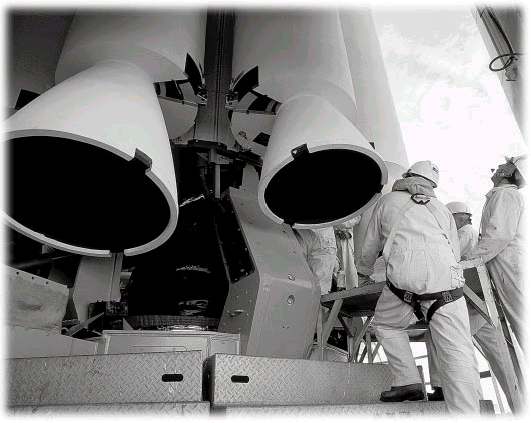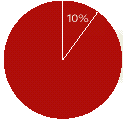|
H
E X C E L M A R K E T S Military aircraft production is set to rise. Already approved military aircraft programs are expected to move from development into production at the start of the next decade, providing a valuable source of sales and earnings. |

Hexcel provides the strength within solid rocket motors used on the Delta family of launch vehicles.
 |
 |
 |
 |
|
Total 1998 Pro Forma Hexcel Sales: $1,235 million Total 1998 Pro Forma Space and Defense Sales: $127 million, or 10% |
THE F-22 is considered the world’s most advanced tactical fighter because of its stealth technology, maneuverability and supersonic flight without afterburner. Hexcel’s IM7 carbon fiber provides the foundation for the primary composite system. |
EUROFIGHTER TYPHOON: Hexcel supplies 8552 epoxy prepregs for all composite structures on the Eurofighter Typhoon, including the wings, front fuselage and tail section. |
RAFALE: This aircraft from Dassault is built using Hexcel carbon and glass prepregs for the wings and fuselage panel sections. |
THE SPACE AND DEFENSE markets have historically been innovators in the use of advanced structural materials, and sources of significant demand for these materials. For example, advanced structural materials played a major role in the development of the so-called “stealth” technologies for military aircraft, and are enabling technologies for the airframes of modern military aircraft.
1 0 P e r c e n t o f T o t a l S a l e s
Today, space and defense comprise an important market for Hexcel, accounting for about 10 percent of total sales. This market encompasses not only military aircraft, but also launch vehicles for spacecraft and satellites, as well as satellites themselves.
Hexcel carbon fibers, honeycomb core, machined core and prepregs are among the preferred raw materials for virtually all major US military aircraft programs and many European programs as well. These include the C-17 cargo craft, the F/A-18, the F-22 tactical aircraft, the V-22 vertical takeoff aircraft, the Comanche helicopter and, in Europe, the Eurofighter Typhoon, Dassault Rafale and Saab Gripen.
M i l i t a r y A i r c r a f t P r o d u c t i o n S e t t o R i s e
Overall, Hexcel’s sales to military aircraft programs increased significantly in 1998. And as the beginning of the new decade nears, military aircraft production is set to rise. Already approved military aircraft programs are expected to move from development into production at the start of the next decade, and to provide a valuable source of sales and earnings following that. The demand for these new aircraft in both the US and Europe is driven by the need to retire and replace older aircraft. Many of the newer models have half of their airframes (by weight) built from composite materials.
The space satellite business, while somewhat slow in terms of revenues during 1998, is an attractive business with good growth prospects. Many new satellites will be needed for voice, data and imaging applications worldwide. Industry estimates call for more than 1,000 new satellites to be launched over the next ten years. Hexcel has become an important participant in this market with the 1997 acquisition of the satellite prepreg business of Fiberite, Inc. In addition to providing materials for satellites, Hexcel also supplies carbon fiber and composite materials for use on satellite launch vehicles such as the Delta, Titan and Ariane programs.
Hexcel’s carbon fiber business experienced some order cancellations during the second half of 1998. These cancellations were the result of excess fiber inventories held by customers as they stockpiled fiber because of the tight carbon fiber market in 1997 and 1998. Inventories should realign in 1999, providing the basis for a rebound in production in 2000.
 |
 |
 |
|
BOEING C-17: The wing-to-fuselage fillet panels produced by Hexcel for the C-17 are honeycomb-stiffened panels of carbon and Kevlar ® /epoxy, ranging from three to 37 square feet in size. |
V-22: The tilt rotor design of the V-22 makes it the only military aircraft able to fly either vertically or horizontally. Most of the aircraft’s structure is comprised of lightweight Hexcel composites. |
EUROCOPTER TIGER: This helicopter has carbon/glass hybrid prepreg engine fairings, glass prepreg blades and a fuselage, cockpit and tail boom built with Hexcel’s carbon prepreg. |
 |
 |
|
ARIANE 5: The newest European satellite launcher contains Hexcel materials in all of its upper sections. The design of the spacecraft incorporates high thermal resistance and acoustic protection to protect delicate instruments. |
SATELLITES: The thermally stable properties of Hexcel’s satellite materials make them perfect for satellites’ bus structures, solar arrays and antennas. |